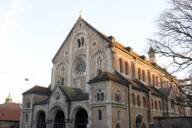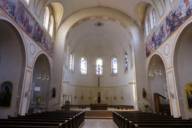
St. Anton Church in Munich's Isarvorstadt district, also known as Antoniuskirche, is located opposite the Alter Südfriedhof (cemetery). It has been remodelled again and again over the centuries and is now one of the Sinnstifterorte (places of meaning) in Bavaria.
‘And if I knew all mysteries and had all knowledge and did not have love, I would be nothing’ – this is not only one of the most popular texts at church weddings, but also the saying of the Capuchin parish in Munich. It is a text from St. Paul to the Corinthians and it is written in large, golden letters on the brick wall of St. Anton Church in Isarvorstadt district. But only a few people know what is hidden behind the broad wall opposite the Alter Südfriedhof (Old South Cemetery): the parish of St. Anton with Antoniuskirche and the ‘Schmerzhafte Kapelle’ (Chapel of Sorrows), whose history dates back to the 17th century.
In the 1890s, the population of Munich suddenly multiplied, even in the previously sparsely populated Glockenbachviertel. This was partly due to the establishment of the neighbouring Schlachthofviertel (slaughterhouse district). The Capuchin monastery of St. Anton, founded in 1846, provided spiritual care, but the old monastery church Chapel of Sorrows became too small as the population grew. Between 1893 and 1895, a new, larger church was therefore built on the west side of the monastery – today's St. Anton Church, also known as Antoniuskirche.
Over the years, the church has been repeatedly rebuilt or remodelled – including after bombing raids in 1943, which destroyed the roof, all the windows and the Third Order Hall. The biggest changes, however, were the church remodelling in the 1960s: As a result of the Second Vatican Council, paintings, altars and all elements that were no longer considered contemporary were removed. Instead of the paintings, the church's architecture was now to take centre stage. However, on the occasion of the 75th anniversary of the parish in 2011, attempts were made to restore the murals – photos of the paintings were printed on banners, which still hang today.
Despite the restoration of the two murals, the interior of St. Anton Church is still very plain today. And this is surprising given its impressive exterior: an opulent brick building with shell limestone and a neo-Romanesque façade. The church is 60 metres long, 24 metres wide and almost 20 metres high inside. In addition to the church, the site is still home to the Chapel of Sorrows, the parish office and centre, the Capuchin convent, the Capuchin provincialate and the premises of the IFP (Institute for Journalism), a Catholic journalism school.

St. Anton Church on Kapuzinerstrasse is part of the Sinnstifterorte (places of meaning) in Bavaria. These places are appointed by the Archdiocese of Munich and Freising and are intended to provide inspiration, contemplation and encounters. There are twelve places in Munich and the surrounding area – including St. Anton and the Herz-Jesu-Kirche in Neuhausen-Nymphenburg district. If you would like to find out more about the services and events in the church, it is best to check the website for the dates. A visit to St. Anton Church can be wonderfully combined with a walk through the Old South Cemetery.